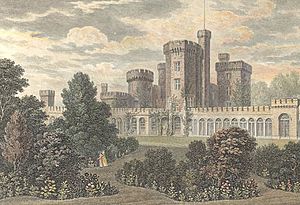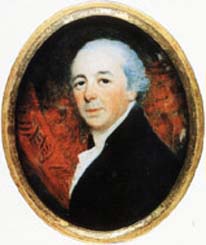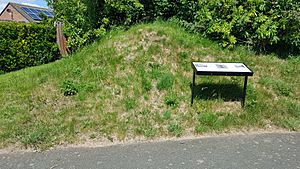East Cowes Castle facts for kids
East Cowes Castle was a grand home in East Cowes, designed by the famous architect John Nash. He lived there from its completion in 1800 until he passed away in 1835. Nash started building it in 1798, and it was said to have cost a huge amount of money. He was even buried on the castle grounds.
The castle was well-known for its unique look. It had many towers and turrets built in a Gothic style, like castles from the time of Edward VI. Many important people visited Nash there, including the Prince Regent, who later became King George IV. The famous painter J. M. W. Turner even painted a picture of the castle.
After Nash died, the estate was sold to the Earl of Shannon. He added a new building called a lodge at the south end. Then, a politician named George Tudor owned it briefly. Finally, the Viscount Gort family bought it and kept it until 1934.
During the Second World War, the army took over the castle. It was badly damaged while they used it. Because it was neglected and fell apart, the castle was torn down in 1963. However, some parts still exist today. The castle's gatehouse, North Lodge, and an old icehouse are still standing. The castle's clock is also on display at the Carisbrooke Castle Museum.
Over the next 30 years, new houses were built where the castle once stood. The estate used to cover the area now surrounded by Old Road, New Barn Road, York Avenue, and Castle Street.
Even though East Cowes Castle is gone, there is an exact copy of it called Lough Cooter Castle. It is located near Gort, in County Galway, Ireland. You can read more about how it was built below.
Contents
- What Was East Cowes Castle Like?
- Lough Cooter Castle: A Copy of East Cowes
- Who Owned East Cowes Castle?
- John Nash (1798 - 1835)
- Henry Boyle, 3rd Earl of Shannon (1836 - 1842)
- Mr George and Mrs Elizabeth Mary Tudor (1853 - 1861)
- Viscount Gort and Lady Elizabeth Mary Gort (1861 - 1880)
- Standish Prendergast Vereker, 4th Viscount Gort (1880 - 1895)
- John Gage Prendergast Vereker, 5th Viscount Gort (1895 – 1902)
- Dowager Lady Eleanor Gort (1902 - 1934)
- Development Plans (1934 - 1963)
- After the Demolition (1963 to Today)
What Was East Cowes Castle Like?
The castle was described as a "marine mansion" in 1842. It had one square tower and two round towers, all with battlements. It was very tall and built with expensive finishes. Inside, there was a dining room, drawing room, and a library. It also had a billiard room, an octagon library, and many bedrooms. There were also rooms for servants, offices, stables, and coach houses. The estate also featured beautiful conservatories, a picture gallery, and well-kept gardens. There were also hothouses and five separate houses.
The Castle Grounds
The castle grounds were designed with the help of Humphry Repton. He was a famous landscape designer who also worked on the gardens at nearby Norris Castle. In 1842, the grounds were about 43 acres, growing to 74 acres by 1934. They were beautifully hilly, with gardens, a gardener's cottage, two lodges, and paddocks. The grounds were laid out in a grand style. They had terraces with tall, lush trees, and long walking and carriage paths. There was also a castle farm.
The Icehouse and Battery
The castle had its own icehouse, which you can still see in Sylvan Avenue. There was also a round, brick-lined pond nearby. This pond supplied ice for the icehouse in winter. The icehouse was mostly underground. It was designed so that ice would not melt, even during the summer.
The castle also had a battery of eight guns. These guns were often fired to give Royal Salutes. This happened when the Royal Yacht visited Cowes.
Lough Cooter Castle: A Copy of East Cowes
This exact copy of East Cowes Castle was built in 1814. It is located on Lough Cooter in County Galway, Ireland. As you know, East Cowes Castle was designed and owned by the famous architect John Nash. He was a favorite of the Prince Regent, who later became King George IV.
How Lough Cooter Castle Was Built
The story of its creation is interesting. Charles Vereker, 2nd Viscount Gort visited East Cowes Castle with the Prince Regent. Viscount Gort told Nash that he wished he could move East Cowes Castle to Lough Cooter. Nash said he could build an exact copy for £50,000. They agreed, and Nash built the copy for him. The final cost was around £70,000.
Lough Cooter Castle became the main home for the Gort family. However, they had to sell it because of the terrible Irish famine in 1846. Strangely, East Cowes Castle later came into the Gort family's ownership. This happened when the Viscount's son, John Vereker, 3rd Viscount Gort, married Elizabeth Tudor. The story says he didn't know East Cowes Castle was identical to his own. He was shocked when she took him to see it on the Isle of Wight. He already knew the layout inside!
Lough Cooter Castle Today
Like East Cowes Castle, Lough Cooter Castle was used by soldiers during the Second World War. It also almost fell apart because of this. But its luck was better. It has now been restored and is considered one of Ireland's most amazing properties. It is privately owned but can be rented for weddings and other events.
Who Owned East Cowes Castle?
John Nash (1798 - 1835)
John Nash designed many famous buildings in London. These include Buckingham Palace and Marble Arch. Many of his projects came from the Prince Regent, who became King George IV. Nash also designed buildings on the Isle of Wight. These include Newport Town Hall, Whippingham Church, and Northwood House. He also designed the ornate arched building on the corner of Newport High Street.
In July 1817, the Prince Regent had dinner at the castle. Four hundred soldiers from Parkhurst Barracks formed a guard of honor. In 1819, the Prince Regent visited Nash again at East Cowes Castle. This was just six months before he became King George IV. In 1825, the Duke and Duchess of Cambridge stayed at the castle.
In August 1830, the Dauphiness and Duchess De Berri visited East Cowes Castle. They were with the exiled King of France. The king had left France because of angry mobs. Cowes was one of their first stops. The Princesses loved the island's scenery.
Nash lived a very fancy life, hosting important guests and royalty. However, later in life, he lost favor. The rising costs of his Buckingham Palace project were part of the reason. Because of this, he never received the honors he might have. He got fewer jobs and fell deeper into debt. It was said he died poor in 1835. His angry creditors demanded his body. So, he was taken to St James's Church, East Cowes at night for the funeral. The castle and everything in it were quickly sold. Six years later, his debts were finally paid off.
Henry Boyle, 3rd Earl of Shannon (1836 - 1842)
Henry Boyle, 3rd Earl of Shannon bought East Cowes Castle and its furniture in February 1836. He paid twenty thousand guineas. He was an Irish politician who served in Parliament. He married Sarah Hyde in 1798 and had twelve children. His son had recently married the daughter of Lord George Seymour, who owned nearby Norris Castle.
Under the Earl's ownership, the castle was called Shannon's Castle. He built the impressive South Lodge gatehouse. It was very different from the North Lodge. Each side of the lodge was two stories high. It had an archway for carriages to drive through. There was a tunnel linking two courtyards. A fake portcullis hung over the arch. One of the pillars from the gatehouse still remains today. The gatehouse was torn down around 1965.
In August 1837, the Dowager Queen Adelaide stayed at East Cowes Castle. She was recovering from a serious illness. Her doctors thought the mild sea air would help her get better. She was the widow of King William IV. The Australian city of Adelaide was named after her.
The Earl of Shannon died in April 1842 at age 70. After his death, his son sent all the castle's furniture back to their family home in Castlemartyr, Cork. This was so the castle could be rented out. For some years, a wealthy gentleman named Nathaniel Barwell Esq. rented the castle.
In 1847, it was reported that the castle had been sold to the Queen Dowager. However, this was incorrect. The next year, it was said that the Marquis of Conyngham was trying to buy the estate. Soon after, it was reported that the exiled former King of France, the Count de Neuilly, had leased the castle for several years. In 1852, Mr Charles Sawyer esq. lived there.
Mr George and Mrs Elizabeth Mary Tudor (1853 - 1861)
The castle was finally sold in 1853 for £12,500. This was much less than its earlier sale price. George Tudor was a Member of parliament for Barnstaple in 1830. He did not get to enjoy the castle for long, as he died in 1857. His wife, Elizabeth Mary Tudor, stayed at the castle. She also owned their main home in London.
In 1855, during a bad thunderstorm, lightning hit the castle. It entered one of the rooms. The only damage was three dozen broken windowpanes. The plumbers and workmen working there were very scared!
Viscount Gort and Lady Elizabeth Mary Gort (1861 - 1880)
In 1861, John Vereker, 3rd Viscount Gort married the widowed Mrs Tudor. He had met her in Paris. He became the new owner of East Cowes Castle. However, he died in 1865 at age 75.
Viscount Gort was a Member of Parliament for Limerick. He was also Mayor of Limerick. He became the 3rd Viscount Gort.
In January 1876, Queen Victoria and Princess Beatrice visited East Cowes Castle. They came to see the Dowager Viscountess Gort. Prince Leopold was also there.
Lady Gort died in October 1880 at age 89. She left £140,000 in her will. Most of her estate went to her stepson, Viscount Gort. She also left £1,000 to East Cowes parish. This money was to start a fund for coal, food, and clothing for the poor at Christmas.
Standish Prendergast Vereker, 4th Viscount Gort (1880 - 1895)
The 4th Viscount Gort inherited the castle in 1880. He was married to Caroline Harriet Gage. He held the office of High Sheriff in 1843. He was also an Honorary Colonel in the Royal Artillery. He was a Justice of the Peace for County Galway.
Standish Vereker made big changes to the castle in 1883. The entrance porch was made smaller. The kitchens were extended, and a new bakery was built. A round tower was built as a separate building. A new courtyard was also created. The work was done very well, using matching materials. Soon after, East Cowes Castle Farm was built on the estate. It had a red brick cottage, a dairy, and other farm buildings.
John Gage Prendergast Vereker, 5th Viscount Gort (1895 – 1902)
In 1895, it was reported that the castle was given as a Christmas gift to John Vereker by his father. He would later become the 5th Viscount Gort. East Cowes Castle was meant to be his seaside home. His wife, Eleanor Surtees, was the owner of Hamsterley Hall.
Like his father, Vereker served in the Royal Artillery. He became a captain. He was also a Justice of the Peace for the Isle of Wight and County Durham. He became the 5th Viscount Gort.
Viscount Gort died in 1902. He left £79,000 in his will. He gave his wife Eleanor use of East Cowes Castle for her life. However, ownership of the castle was held in trust for his second son, the future 7th Viscount Gort.
Lady Gort kept ownership of Hamsterley Hall. She later married Colonel Starling Meux Benson in 1908. Both she and her new husband died in 1933.
Dowager Lady Eleanor Gort (1902 - 1934)
East Cowes Castle remained under Lady Gort's control. It was held in trust for her children until she died.
Her eldest son, 6th Viscount Field Marshal Gort, was a highly decorated war hero. His younger brother, Standish Vereker, 7th Viscount Gort, was also a war hero.
When Lady Eleanor Gort died in 1933, the castle's contents were sold in August. It seems that even though it was held in trust, the castle never legally went to either of her children.
The castle itself was auctioned in November 1934 and sold. The buyer's name was not shared. It was hoped the castle would be lived in again. The next week, it was announced that a company was being formed to manage the estate.
Development Plans (1934 - 1963)
In 1934, Cowes Estates LTD, a development company, bought the castle. Until the start of the Second World War, only caretakers lived there. For a short time, it was used as summer tea gardens for visitors.
In 1940, during the Second World War, the military took over the castle. They left it in a very bad state. It was used to house British and Canadian soldiers. The grounds were also used for air-raid shelters for 150 people. There are stories that doors and fancy wood panels were taken down and burned in fireplaces to warm the freezing soldiers.
By 1946, the castle was in terrible condition. The lead roofing and floorboards had been sold or used to fix bombed local homes. Once rain got in through the roof, serious decay began. Because of its condition, no one wanted to pay to restore it.
By 1951, it was announced that the castle would be torn down. By the next summer, its once beautiful lawns were to be used to grow strawberries. Workers were already stripping the castle of its fittings. There were bonfires all over the estate as more trees were pulled up and burned.
A company called Cowes Growers LTD was responsible for growing fruit and vegetables. Winter lettuce had already been planted. They planned to plant 10,000 strawberry plants. They also planned to grow raspberries, apples, cucumbers, and blackcurrants on the 58 acres. There were some plans to save parts of the castle, but these were not practical.
In 1958, the run-down estate was sold for just £1,000 to Mr Arthur Guy. He asked for permission to build a holiday development and an 18-hole golf course. This would have saved the castle. However, his request was refused. He then sold the site to other developers, hoping the castle would still be saved. But it was not.
Finally, in 1963, the castle was completely torn down. The Southgate Lodge followed soon after. Over the years, houses have been built on most of its grounds. However, the original northern gatehouse, North Lodge, still stands in Old Road, East Cowes.
Stone from the demolition of East Cowes Castle was later used to rebuild West Cowes Castle. This is the home of the Royal Yacht Squadron.
After the Demolition (1963 to Today)
Over the next thirty years, new housing developments were built on the estate. These include Sylvan Avenue, Birch Close, Vereker Drive, and others.
In 1989, people tried to save East Cowes Castle's icehouse. It was the only other remaining part of the castle's original estate. It was in the middle of the new Sylvan Avenue housing development. The bottle-shaped brick building was about twelve feet high. It was partly buried underground, next to a new building. There was a large hole in the roof. But the Isle of Wight Council architect thought it could be saved if the hole was fixed. At that time, there were about twenty icehouses left on the Isle of Wight.
The icehouse was indeed saved. The Isle of Wight Council agreed to take care of it in March 1990. It was loosely filled with chalk to keep its shape. Then, it was buried under a grass mound to preserve it. This way, it might be rebuilt properly in the future. There is an information board there to explain its history.
In 1997, the clock movement from a square turret in the castle was put on display at Carisbrooke Castle. The clock was built in 1819 by Clerkenwell clockmaker John Moore. He supplied clocks for churches and towers worldwide. It was restored in 1995 and is now working.






